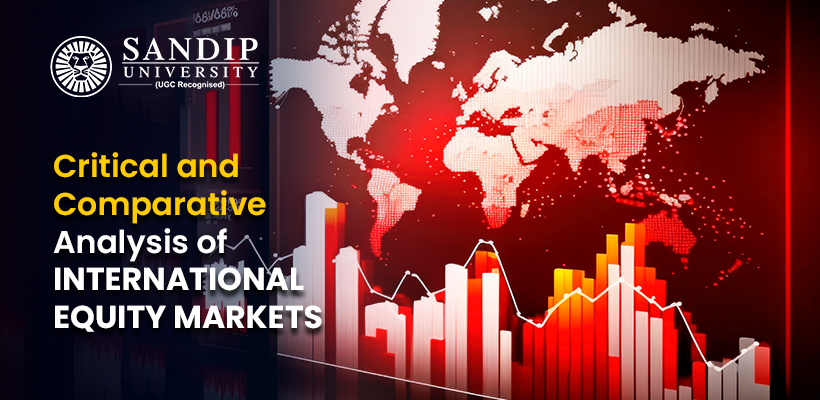When a financial market makes the commitment to go international, it must choose an entry strategy. This decision should reflect an analysis of market characteristics (such as potential savings, competition, strategic importance, strengths of local resources, cultural differences, and country restrictions and deregulation. In addition, company capabilities and characteristics, including the degree of near-market knowledge, financial marketing involvement, and commitment that management is prepared to make must be considered.
There are many MBA colleges in Nashik that provide value addition and global certification programs related to international equity markets to students specialising in banking and financial management. Let us take a look at the comparative and critical analysis of international equity markets:
Management of Equity by Financial Companies
Financial Companies most often begin with modest service involvement. Generally, foreign companies enter markets in other countries through exporting, agreements through contracts, strategic alliances, and direct foreign investments. There are other ways of entry like equity or non-equity requirements of foreign companies. Moreover, the value of equity needed by the company to utilise various modes which affect the risk, income, and controls which have in all modes of foreign equity market entries.
The firms can acquire their resources through the international equity market to cater the needs of them. The main objective of this article is to test whether there is any significant difference from American exchanges, Asia–Pacific exchanges and Europe–Africa–Middle East exchanges in terms of number of listed companies, value of shares trading, number of trading days, number of ETFs (Exchange Traded Fund) listed and number of ETFs traded.
Results of the SPSS 16.0 Study
The SPSS 16.0 version was applied to derive the results by applying the techniques of paired samples, test, paired samples correlation and paired samples statistics. The study found that a higher number of listed companies represented from the Asia–Pacific followed by the Europe–Africa–Middle East and American exchanges and there was a significant difference that had taken place from one region to another region. The more value of shares trading had taken place regarding the American exchanges followed by the Europe–Africa–Middle East and Asia–Pacific.
The number of trading days of the international equity market had taken place regarding the Europe–Africa–Middle East followed by the Asia–Pacific and American exchanges and observed that there was a significant difference from one region of exchange to another region of exchange. Findings also came to know that more of the ETFs listed regarding Asia–Pacific exchanges followed by the Europe–Africa–Middle East and American exchanges and found that the significant difference had taken place between each other.
The number of ETFs traded regarding Europe–Africa–Middle East followed by the American exchanges and the Asia–Pacific exchanges and there was no significant difference between each other regarding the number of ETFs traded. The very strong relationship established between American exchanges to Asia–Pacific exchanges and negatively correlated regarding Europe–Africa–Middle East exchanges to the Americas exchanges in terms of no. of listed companies in the international equity market.
The number of ETFs listed under the international equity market of various stock exchanges had taken place regarding Asia – Pacific exchanges followed by the Europe–Africa–Middle East and American exchanges and the very strong relationship established from one region to another region of exchange and there was a significant difference from each other.
Conclusion
The main aspect of this area is the current trend analysis of stock investments are compared with various stock exchanges in the global scenario in terms of qualitative and quantitative manner. Comparative analysis has been made in the following areas such as equity market capitalisation, securities of listed companies, basing on listed agreements, settlements, and futures.
In terms of capitalisation of equity markets the clear idea can be understood through the size of concerned stock exchanges in their countries. The listing agreements are usually taking care of the policies and regulations of the concerned financial portfolio of the countries.
The effectiveness of a stock exchange was measured based on its final settlement of equity shareholders on time. Moreover, the capitalisation of equity markets is based on their headquarters, branches and size of corporations scattered throughout the international exchanges.

